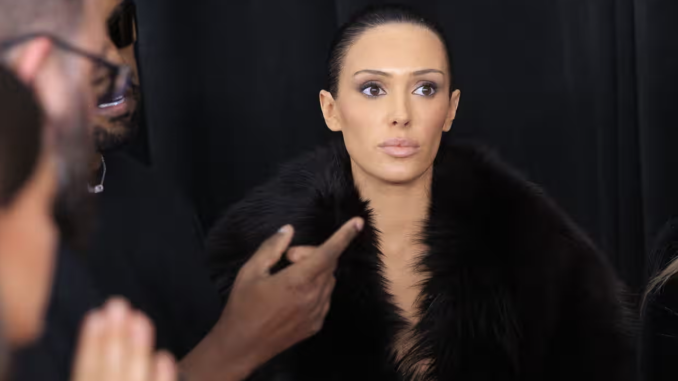
Introduction
This analysis will compare two online news articles from The Guardian and The Conversation about Bianca wearing a see-through costume at the Grammy Awards. The comparison will reveal the different approaches to delivering online news between legacy news and digital born news platforms in terms of content production, interactivity, and user experience.
Publishing contexts and user analysis
The Guardian
The Guardian was founded in Manchester in 1821 and became a national daily newspaper in 1959. It is owned by the Guardian Media Group, which in turn is owned by Scott Trust Limited. This means that The Guardian is not owned by shareholders and is intended to ensure its press freedom and financial independence. This also gives it a unique market advantage of making high-quality investigative journalism and independent reporting available to all readers without a paywall.
This business strategy may have taken into account The Guardian’s target user groups. According to The Guardian Advertising (2024), almost half of The Guardian’s 2023 audience in different countries are aged 25-44 and at least a quarter have a university degree. Economically, the audience is dominated by middle- to high-income management groups.
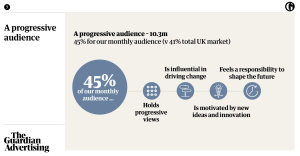
In addition, 45% of the audience feels motivated by new ideas and innovations as well as responsible for shaping the future (Figure 1). In this case, The Guardian’s readership, characterized by higher education, financial independence and public responsibility, tends to focus on in-depth and socially relevant news stories. Thus, The Guardian’s strategy of encouraging users to donate rather than imposing a paywall to force payment demonstrates its commitment to transparency and public accessibility of information, in line with the values of its readers.
The Conversation
Founded in Australia in 2011 by Andrew Jaspan and Jack Rejtman, The Conversation is an independently operated digital born non-profit news platform. Over 50% of its funding comes from individual donors and 39% from partners in the university and research sector (The Conversation, 2025). The Conversation’s unique marketing competency is that all of its work is free to read and free to reprint under Creative Commons. Additionally, authors can only write about topics they specialize in and must disclose potential conflicts of interest. These mechanisms ensure the professionalism, transparency and credibility of the content and reinforce The Conversation’s unique role in knowledge dissemination and public service.
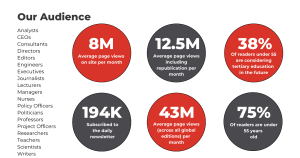
The Conversation’s readers are 75% under the age of 55, as shown in Figure 2, and 38% of them are considering higher education in the future, indicating a strong need for self-improvement (The Conversation, 2024). The readership has a wide range of occupations, including government, education, healthcare and technology. Therefore, they are likely to be young and middle-aged people who have a certain amount of knowledge but want to expand their minds and gain professional perspectives through reading. Compared to The Guardian, which tends to provide in-depth coverage of cultural and social issues, The Conversation is more focused on giving the public access to professional and academic knowledge.
Writing and content production
In terms of story form and writing style, The Guardian’s reporting belongs to the commentary genre of writing, with a distinctly personal viewpoint and persuasive writing style. Admin (2022) said commentaries are about sharing opinions and analysis on a specific topic and thus columnists are not required to be objective. For example, the article mentions that
“There is a clear desire to shock in her appearances with West, but there is no playfulness” (Donegan, 2025).
This sentence exemplifies the typical writing style of a commentary article. The writer is not describing events objectively, but rather expressing a subjective opinion based on personal observations.
Although the article published by The Conversation is not a traditional news report, it can be categorized as an analytical feature that explores the socio-cultural significance of the nude dress through the perspective of fashion history. Thus, the language style of this article is more objective and rational than The Guardian’s.
While both news stories discussed Bianca Sensori’s controversial dress choice at the Grammys, they differed significantly in terms of accuracy and source credibility. This can be compared in terms of citation links, author information and visual representation.
First of all, since the genre of The Guardian’s article is commentary, this makes it mostly personal opinion. Hence, there are fewer external references cited in the article than The Conversation’s, and only limited citations and hyperlinks are provided to support its opinions. For example, the article’s reference to Kanye West posting a tweet praising Hitler lacks screenshots or links to prove it. While The Conversation’s article refers to fashion history and past celebrities’ events such as Rose McGowan and Kendall Jenner, this use of examples and evidence enhances the persuasiveness and reliability of the analysis.
Secondly, the two articles differ in authorship and their credibility. Son (2020, p. 38) pointed out that journalists’ identities should not only contain basic job information, but also their online presence and verifiability, such as e-mail addresses and social media accounts, in order to establish a specialized and credible public image. The Guardian’s article was written by Moira Donegan, however, the webpage only states that she is a Guardian US columnist and other articles she has written, with no other indication of her identity or stance. In contrast, The Conversation’s article was written by Harriette Richards, a senior lecturer from the School of Fashion and Textiles, whose writing is within her subject area, which provides a research base for the analysis and enhances credibility through expertise.
Finally, from the visual aspect, The Conversation uses more relevant images. These images are not only decorative, but also enhance the reader’s understanding and strengthen the argument. Whereas The Guardian’s article contains only one image, which is mainly used for background rather than analysis.
Online delivery
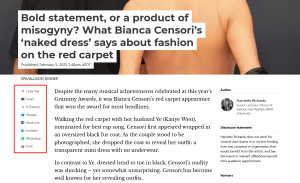
Both The Guardian and The Conversation include some important online delivery features, such as social media sharing and “read more” sections. However, the way these features are implemented reveals subtle differences in user interaction design. For instance, for The Guardian’s social sharing options, users must click on generic share buttons before selecting specific platforms such as Twitter and email. While The Conversation puts separate share buttons directly on the article page for quicker sharing (Figure 3). This detailed design emphasizes The Conversation’s commitment to making content more shareable, consistent with its open access publishing philosophy.
Regarding author interaction, The Conversation provides clearer contact information. The webpage contains the author’s name, academic institution and contact information such as her Twitter account. This transparency promotes direct communication between readers and the author. The Guardian‘s article does not provide contact information for Moira Donegan, which limits the possibility for readers to interact outside of the article.
As indicated by Bradshaw (2023, p. 294), interactivity control means that the control over the input of news content includes allowing readers to comment or vote. Although neither of these two news sites offer comment sections for articles, which reduces the opportunity for user-generated content. However, the author contact information provided by The Conversation compensates for this to some extent. Therefore, it seems that legacy media have a much tighter grip on content and interactivity.
Technical delivery
Both The Guardian and The Conversation offer clean and well-structured web pages with easy-to-use navigation and layouts suitable for mobile devices, yet there are still many differences. According to Bradshaw (2023, p. 78), two of the basic principles of web writing are brevity and scannability.
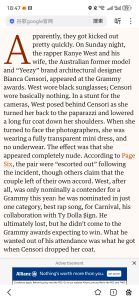
In terms of brevity, The Guardian’s paragraphs are too long with minimal spacing. Such large paragraphs are not conducive to online reading, especially when readers are using their mobile phones to read the news, which may reduce the readability and brevity of the article (Figure 4). In contrast, The Conversation’s paragraphs, which mostly consist of one to three sentences, are more appropriate lengths for reading.
Scannability is the ability of a website to allow users to quickly find the information they are looking for while browsing the web (Bradshaw, 2023, p. 82). Firstly, from the headline, The Guardian’s headline is more cryptic and only mentions the key person. Whereas The Conversation’s headline is clearer and allows the reader to better understand the main content of the article.
In addition, the lack of subheadings and visual elements in The Guardian’s coverage to delineate the key points of the article results in dense text, which does not help with quick scanning. Conversely to The Guardian, The Conversation uses appropriate subheadings as well as multiple images to separate text, making it easy for users to quickly locate information as well as match the pace of the reading. It can therefore be seen that The Guardian has to some extent retained the linear reading style of traditional paper media, while The Conversation is more suited to the fragmented reading style of online news.
Conclusion
In conclusion, The Conversation is better than The Guardian at delivering a more user-friendly reading experience, including accuracy, interactivity and technological usability. The Guardian’s strength is its strong personal style, but its delivery form retains a print media style. This demonstrates how digital born news platforms are reshaping the way we access and interact with news.
References
Admin. (2022, August 10). Understanding the difference between news, commentary, and letters to the editor. Maple Lake Messenger. https://maplelakemessenger.com/2022/08/understanding-the-difference-between-news-commentary-and-letters-to-the-editor/
Bradshaw, P. (2023). The online journalism handbook: Skills to survive and thrive in the digital age. Taylor & Francis Group.
Donegan, M. (2025, February 5). The exposure of Bianca Censori’s body is contrasted with the enigma of her mind. The Guardian. https://www.theguardian.com/commentisfree/2025/feb/04/bianca-censori-kanye-west-grammy
Richards, H. (2025, February 5). Bold statement, or a product of misogyny? What Bianca Censori’s “naked dress” says about fashion on the red carpet. The Conversation. https://theconversation.com/bold-statement-or-a-product-of-misogyny-what-bianca-censoris-naked-dress-says-about-fashion-on-the-red-carpet-249001
Son, J. (2020). Online journalism and storytelling: A training and learning kit. Fojo Media Institute. https://fojo.se/onlinejournalismkit/
The Conversation. (2024). Media Kit 2025. https://cdn.theconversation.com/static_files/files/3535/Media_kit_2025.pdf?1731559569
The Conversation. (2025). Stakeholder report 2024. https://cdn.theconversation.com/static_files/files/3573/2024_Stakeholder_Report_AU_NZ__%2810%29.pdf?1734410202
The Guardian Advertising. (2024). The Guardian Media Kit 2023. https://advertising.theguardian.com/assets/files/media-kit-2023.pdf





Be the first to comment